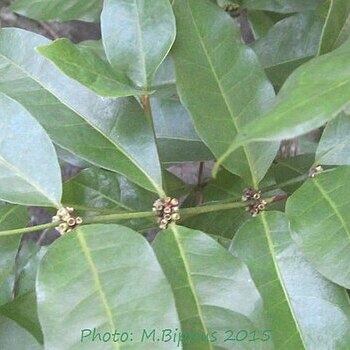Flowers sessile or rarely pedicellate, usually small in axillary sessile or pedunculate bracteate clusters; bracts and bracteoles forming a complicated pattern of primary bracts; secondary bracts often supporting triads of flowers, and bracteoles often several per flower; usually joined to form a cup at the base of the calyx.
Leaves usually thinly coriaceous with a characteristic divaricate venation, usually oblong-elliptic to lanceolate, less often more rounded; domatia absent; leaves subtending lateral branches often differing from those on main stems (smaller and broader in shape).
Ovary 2-locular; ovule solitary in each locule, pendulous; style filiform, exserted, shortly pubescent or hairy, or apparently glabrous in one imperfectly known species, with filiform undivided or rarely ± ellipsoid or slightly to distinctly bifid stigma.
Corolla glabrous or puberulous outside; tube narrowly funnel-shaped or cylindrical, densely hairy at the throat; lobes 4–5, strictly contorted, overlapping to the left (as seen in bud), ovate to oblong, acuminate, spreading.
Calyx glabrous or puberulous outside; tube campanulate or turbinate; limb-tube cup-or bowl-shaped, obconic or sometimes tubular, occasionally covering the corolla in bud, truncate or 4–5-toothed, persistent.
Stamens 4–5, inserted in the corolla tube, the filaments very short; anthers linear, fixed at the back near the base, included or partly exserted, sometimes minutely apiculate.
Seeds subglobose to plano-convex with striate-sulcate testa and very ruminate endosperm.
Fruits globose to subglobose with a rather tough epicarp, 1–2-locular, 1–2-seeded.
Glabrous or hairy shrubs or small trees with supra-axillary branches.
Stipules triangular, acuminate or aristate with a raised mid-line.
Disk small but evident, fleshy.

